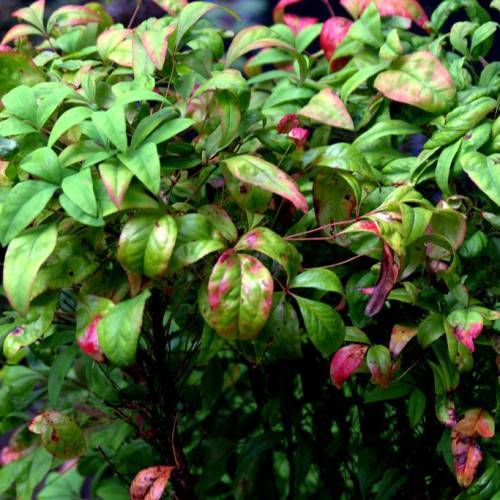
heavenly bamboo
Nandina domestica 'Pygmaea'
Cycle:
Perennial
Watering:
Average
Hardiness Zone:
6 - 9
Flowers:
Flowers In Summer
Sun:
Part sun/part shade, Sheltered
Fruits:
Fruits In Autumn Ready In Fall
Leaf:
Yes
Growth Rate:
Moderate
Maintenance:
Moderate
Drought Tolerant:
Yes
Care Level:
Medium
watering
Water heavenly bamboo plants every 2 weeks during the spring and summer, and every 4 weeks in the fall and winter. Be sure to water deeply, as heavenly bamboo appreciates a thorough soaking. In the summer, water the soil thoroughly until water flows from the pot’s drainage holes. During the winter, water until the top 2 inches of soil is moist. Adding a layer of mulch around the plant helps keep the soil cool and moist in the summer.
sunlight
Heavenly bamboo (Nandina domestica 'Pygmaea') needs direct sunlight in order to thrive and is best suited for full sun or part shade (morning sun with afternoon shade). It will do fine in partial or dappled shade as well. It can tolerate full shade, however it may not produce fruit with this exposure. The exact amount of sunlight an individual plant needs will depend on the climate and other environmental factors. In general, plants in warmer climates will need more sun exposure than plants in cooler areas. In addition, plants need a few hours of sunshine every day in order to flower and set fruit. If too little sunlight is present, they will not be as productive. If your heavenly bamboo is in a shady spot, supplement the sunlight with artificial light, such as a grow light or sun lamp.
pruning
Heavenly bamboo, or Nandina domestica 'Pygmaea', requires moderate pruning once every year. Prune the plant in late spring or early summer, just before new growth starts. Remove any dead, diseased or damaged branches, along with branches that are crossing each other or growing in an unruly manner. It's best to prune only a portion of the plant at a time, as excessive pruning can weaken the health of the plant. Pruning selected branches back to the desired shape will help maintain the plant's rounded form. To maintain the dwarf size of the heavenly bamboo, remove any stems that have grown taller than 12 inches.
